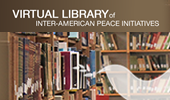| Home |
||||||
| Peace Week 2009 | ||||||
| The OAS organized a series of events during Peace Week -- September 21-25, 2009 -- in commemoration of this landmark initiative to promote universal values and social practices related to ideas of respect, brotherhood, and mutual understanding, which include a keynote conference by former guerrilla hostage and vice presidential candidate Clara Rojas of Colombia (Monday, September 21); the screening of the world renowned documentary “The Day After Peace”, about the efforts of filmmaker Jeremy Gilley to establish the first ever annual day of global ceasefire and non-violence (Wednesday, September 23); a display of historic photographs from the Columbus Memorial Library that document the prominent role of the OAS and its predecessor agencies in peace efforts from 1889 to the present; a selection of some of the most important works of the Permanent Collection of the Art Museum of the Americas with a thematic connection to peace (September 21-25); a concert featuring the youth symphony orchestra “Peace Notes” made up of underprivileged children from Cali, Colombia (Friday, September 25); and Chalk4Peace, a global chalk art project which turns pavements into a blank canvas where young artists of all ages can create messages and images that materialize their visions of peace (Saturday, September 26). | ||||||
| See full “Peace Week 2009” program | ||||||
| The Inter-American Peace Forum 2009 The Peace Week was inaugurated at the headquarters of the Organization of American States (OAS) on September 21, 2009, with the participation of Clara Rojas, lawyer and once hostage of the Revolutionary Armed Forces of Colombia (FARC), as keynote speaker of the Inter-American Peace Forum 2009. In his introductory remarks, the Secretary General of the OAS, Jose Miguel Insulza, commented on the fact that the celebration of the event coincides with the commemoration of the International Day of Peace, established in 1981 by the United Nations as “the day in which human beings commit to peace, to cease-fire, and to non-violence.” Insulza said that “Clara Rojas is a symbol of strength that incarnates the hope of all those who suffer from injustices and who hope for peace, liberty, and rights.” He referred to some of the economic and social concerns that the region is facing today and added that to achieve peace “it is necessary to strengthen the incentives that encourage the formation of values and social practices aimed at resolving political, economic, and social conflicts through dialogue, respect for differences, and cooperation, and not with the use of force and violence.” In her presentation, Clara Rojas made some references to her personal experience and to the lessons learned after almost six years of captivity. She affirmed that from her perspective the search for peace “is not an empty speech” and that “today, maybe more than ever, it is necessary to reopen the path of dialogue and understanding, not only within countries but also among the states of the American continent.” With these words, Rojas called on the leaders of the region so that their differences may be “solved based on mutual respect, dialogue, and comprehension, and remembering principles and commitments. But, above all, with concrete probes and gestures that send precise signals on the real desire to maintain and sustain agreement.” Likewise, she expressed that the work of the regional leaders must be the one that “shows us that the sense of humanity and of coherence is greater than the temptation of power and vanity.” By remembering recent experiences, the former vice-presidential candidate talked about the importance of breaking the chain of fear, and affirmed that “the first step has already started with the protests that took place in Colombia and in many countries of the world, where millions of people went out to the streets to say no to kidnappings and to demand the liberty of their fellow countrymen.” She also took the opportunity to remember the police officers and uniformed men that are still in captivity, and in the framework of the forum she sent them “a message of resistance, inspiration, and solidarity.” In her presentation, Clara Rojas highlighted the role that the OAS has played in the promotion of peace and democracy, and recalled the recent General Assembly of the OAS that adopted the Declaration of San Pedro Sula: “Towards a Culture of Non-Violence”. She said that “it is a positive message that this Organization recognizes that we live in times of violence in the hemisphere and that we must focus on joint efforts to promote peace.” Clara Rojas also expressed concerns for the recent announcements of arms acquisition in some countries of the region, and for “the weak control of illegal markets that allow an easy access to firearms.” In this sense, she stated that “a path towards peace can not be built if America is heavily armed”, then she suggested that at the heart of OAS activities there must be a space to debate this type of agreements. The Peace Forum speaker closed her presentation commenting on the necessity to “renovate the commitment of all our countries to again build mutual confidence, respect, and solidarity, and work together so that the results are reflected in the establishment of lasting peace for the Americas.” Inter-American Peace Forum Monday, September 21, 2009 Hall of the Americas, OAS Washington, D.C.
|





